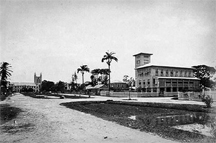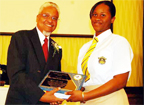Queen’s College observes its 165th anniversary
This year marks the 165th anniversary of the establishment of Queen’s College − the most prestigious educational institution in Guyana’s history.

The Caribbean Examination Council’s press release last year made the point: “For the third consecutive year, a student of Queen’s College, Guyana is the Most Outstanding Candidate Overall in the Region in the Caribbean Secondary Education Certificate (CSEC) examinations. Miss Yana-Marisa Edwards, a student of Queen’s College, Guyana achieved Grade I in 14 subjects and a Grade II in one subject.” Yana-Marisa followed Wainella Isaacs in 2007 and Shivarnie Persaud in 2006, respectively, as the top student in the region from Queen’s College, Guyana in the last three years.
This year, another Queen’s College student – Wallisa Roberts – recorded an outstanding performance at this year’s Carib-bean Advanced Proficiency Examination (CAPE) with five grade one passes. This year, also, Kia Persaud and Padminee Roshundatt of Queen’s College each obtain-ed 14 grade one passes, respectively, at the Caribbean Secondary Education Certificate results. Queen’s College produced 27 of the 97 candidates who gained grade one passes in at least eight subjects.
More than any other secondary school in the country, Queen’s had much to celebrate when it observed the 165th anniversary of its establishment on 5th August. The College has educated two presidents, three prime ministers, three chancellors of the judiciary, several chief justices and high court judges and thousands of assorted academics, bureaucrats, businessmen, diplomats, scientists and other professionals.

Even the composition of the current cabinet of ministers is evidence of the high-level representation of Queen’s alumni – Prime Minister Samuel Hinds; Minister of Public Works Robeson Benn; Minister of Human Services and Social Security Minister of Human Services MPriya Devi Manickchand; Minister of Finance, Dr. Ashni Singh; Minister in the Ministry of Finance Jennifer Webster and Cabinet Secretary Dr Roger Luncheon.
The College’s reputation for scholarship is not a flash in the pan but a well established historical fact. Winston Mc Gowan’s A Concise History of Queen’s College cites a UNESCO Educational Survey Mission to British Guiana from November 1962 to March 1963 reported that “Queen’s College has won for itself the unenviable position of the premier school of British Guiana…there is a great deal of evidence to support the claim for it as the premier school of the Caribbean. The whole tone of the school is permeated by the tradition and reputation built up over the years”.
Background
Originally called the Queen’s College Grammar School, the College was established by the Right Reverend William Piercy Austin, the Anglican Bishop of British Guiana and its first principal, on 5th August 1844. The Ordinance of 14 August 1848 to incorporate the College stated that it was designed “to provide an efficient system of education at a moderate expense − open to all members of the community without distinction. But, although it was open to all boys, irrespective of race or class, it was known to be aimed at providing education for the sons of the colonial élite whose parents could not send them to Britain for their schooling.
Queen’s has changed much over the years. The first and most noticeable change was in ownership. Established as a private institution, owned and governed by the Anglican Diocese but supported from 1849 by an annual Government grant, it became a Government institution, offering a secular non-denominational system of education in 1876, the year of the introduction of the Compulsory Denominational Education Bill and other reforms. In so doing, the College became both secular and a national institution.
The second change was in location. Located originally in temporary quarters in what is now the premises of the High Court in Georgetown, it moved to a property at the corner of what today are Main and Quamina Streets remaining there until 5th September 1854 when its own buildings were opened at the corner of Carmichael and Quamina Streets on the current site of the Bishops’ High School. This building was vacated in 1918, when the school moved to Brickdam and Vlissingen Road to the premises occupied by the Ministry of Health which was burnt down in July. The College remained there until 1951 when it occupied its current facilities at Camp and Thomas Roads in Longden Park, Thomas Lands.
The effect of this final move was phenomenal. Constructed in North George-town’s breezy ‘green belt’ and furnished with more commodious premises and facilities − a large auditorium with an excellent stage, 24 classrooms, 6 modern science laboratories, a library, a workshop for woodwork, an administrative office, staff room, spacious playing fields − the College could afford an enlarged student intake, an expanded curriculum and an increase in the amount and variety of recreational, cultural and other extra-curricular activities.
There was also ample housing for the principal, senior masters and expatriate staff. The commodious building quickly became the main centre of a wide array of non-academic events – music festivals and concerts; state banquets; classrooms for the University of Guyana and, most inconveniently, temporary barracks for the British Army during the 1962 troubles.
This excellent, multi-purpose edifice suffered a serious setback when a substantial portion − including the auditorium, principal’s and administrative offices, staff room, Physics and Chemistry laboratories, fifth and sixth form classrooms, the industrial arts room, Computer Learning and Resource Centre, the tuck shop and the cycle bay − was destroyed by arson in November 1997.
Curriculum
According to Norman Cameron’s History of Queen’s College, “The scheme of work was based on that of King’s College, London.” The original curriculum was to be Classical and Commercial – to combine Theological Training with study of Classics, Mathematics and Modern Languages”, and a few other subjects on the principles. The major concern then was to “keep up efficiently the full course taught on the classical side of an English Public School or First Grade Grammar School.”
In the early days, most time for instruction was allotted to Latin, Greek and to French. Although the teaching of Chemistry and Physics had been introduced in the late 19th century, science education made little progress until a new science laboratory and classroom were added to the school’s facilities in 1896.
The occupation of the new premises in 1951 and the arrival of a new science-minded principal – Vyvyan Sanger-Davies – made a big difference. Students from the fourth form were separated into predominantly Science (‘Modern’) and Arts (‘Classical’) streams from 1953. Queen’s also offered students from other secondary schools the opportunity to study science subjects by allowing them to enter the College through a newly-created fifth form – called Remove Modern – in which they were prepared to write the General Certificate of Education Ordinary and, in the Sixth Form, the Advanced level, examinations in Science and Mathematics.
The balance was eventually achieved in the school’s curriculum in three areas. First, between science and the humanities and between these areas and business education. Second, the inclusion of music, physical education, woodwork and other non-examination subjects. Third, by a full range of extra-curricular activities, with a high score set on participation in games in particular. By the 1950s, students at Queen’s could participate in at least eight games – athletics, chess, cricket, football, hockey, table tennis, volleyball and the school was represented in local competitions in these sports.
Students also benefitted from involvement in the College’s numerous societies and clubs which, by the 1950s, included the Literary and Debating, Junior Debating, Historical, a Science Society, Dramatic, Bee-Keeping, Philatelic, Photographic and Co-operative societies and the Bible Club, Radio Club, Poultry Club, Educational Tour Club and Pen Pals’ Clubs. The College possessed vibrant a Cadet Corps and a Scout Troop.
Not least of all, a body of quaint traditions – the cork helmets (called bug houses); House Feeds; the Latin College Hymn Carmen Colegii Reginae and the Songs of Praise; the House system; the Lictor newspaper and annual College magazine with its On Dit column; detention ‘with manual labour;’ six of the best from the principal; the Cadet Corps; the Remembrance Day observances – created the wonderful esprit de corps which made education if not enjoyable at least endurable and certainly memorable.
Clarence Trotz’s History of Queen’s College points out that, with the advent of girls in the school in September 1975, the curriculum of the school was greatly widened. Apart from the traditional so-called academic subjects, ‘practical’ subjects such as home economics, shorthand, typewriting, industrial arts and agricultural science were introduced making the college much more ‘multilateral’ that it had ever been before and giving boys and girls an equal opportunity to choose from the newly-introduced subjects.
The expanded curriculum and these extra-curricular activities made an invaluable physical, educational, intellectual, aesthetic, cultural, technical, moral and spiritual contribution to the students’ education.
Students
The College started with merely 15 students – the sons of the more affluent members of the élite – who alone could afford to pay the admission fees. By the late 1940s, Queen’s had a growing proportion of students of lower middle-class origin. This was because, from 1945, the Government began to offer a rapidly increasing number of scholarships or free places to students to enter Queen’s and the other leading Govern-ment secondary schools based on their performance at the annual secondary schools entrance examination.
The last significant change in the composition of the student population of the College occurred in 1975 when the school ceased to be an institution exclusively for boys and female students were admitted on a full-time basis for the first time, in keeping with a new policy of the Government of making all learning institutions co-educational.
The College also witnessed significant changes in the teaching staff. At the start, the staff consisted of a principal and two teachers – all white clergymen and the school profitted from the fact that most were university graduates. A convention emerged of recruiting staff – except expatriates and females – almost exclusively from among former students of the school, thus perpetuating the school’s traditions but this convention has lapsed.
Throughout most of the history of the school, the staff has been almost exclusively male but this changed after the school became co-educational in 1975. The first female principal was appointed only in 1989.
Challenges
The post-Republican years have been very challenging for the College although it has been able to maintaining its prized reputation as the country’s best secondary school. The greatest challenge has been a decline in the quality of the teaching staff owing mainly to the brain drain – emigration of graduates – and a relative reduction in financial support from the Government.
As a consequence, the College has been unable to maintain its laboratories, playing fields and its rich extra-curricular life and many students have been forced to take the unprecedented step of seeking private lessons externally to supplement the tuition.
Queen’s College has made an invaluable contribution to the country throughout its history, producing many of the outstanding Guyanese in every field of endeavour. The academic, professional, political and cultural life of the country has depended largely on the College’s graduates.
According to Mc Gowan, the College has been acclaimed for three qualities – first, the quality of its balanced education; second, its academic success, and third, its tradition and objective of excellence – in its 165-year existence. The College’s long history has confirmed the validity of its Latin motto, “Fideles Ubique Utiles” (“Faithful and Useful Everywhere”).
